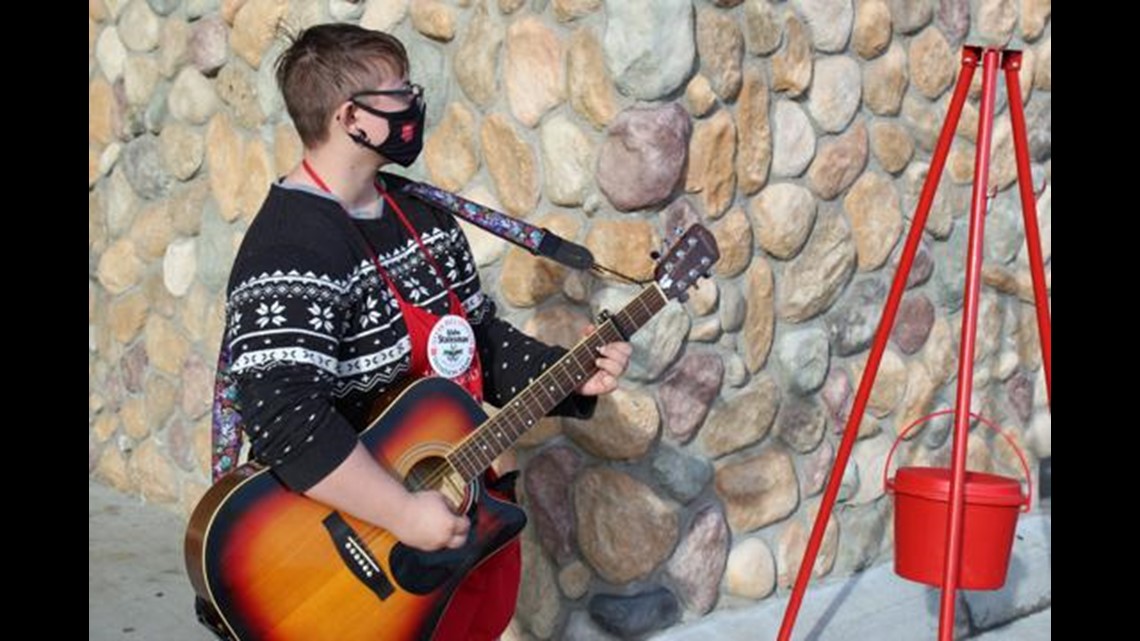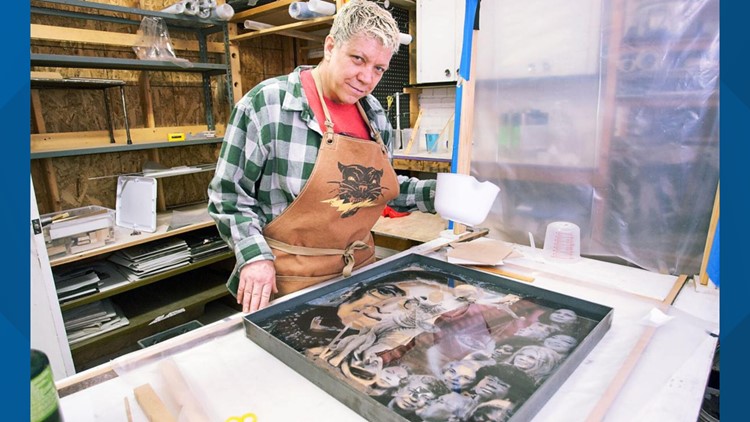BOISE, Idaho — This article originally appeared in the Idaho Press.
It was Sunday, Aug. 2. Sue Latta, who was in the final whirl of readying her art for an exhibition set for Thursday, opened the door to her studio. But instead of walking into the nearly complete show of sculptures and art pieces ready for hanging, Latta walked into a nightmare. Overnight, the studio had been broken into and vandalized, art works mutilated and torn asunder. One piece, a sculpture of her own head, a self-portrait, was broken into pieces. Which was how Latta felt.
“They broke my head. Literally,” she posted on Facebook.
Latta also posted a Facebook Live video from the scene. Raw, and in shock at the destruction all around her, she relayed in real time, what she was seeing and how she was feeling. The video, as they say, went viral. And while Latta said she was numb and nearly paralyzed in that moment, it wasn’t long before people in the community reached out.
“It was almost immediately. Within minutes I got the first phone call,” Latta said. “Then people just started showing up.” And it wasn’t just close friends. “People, not everyday-in-my-life people.”
Over the course of the day, they came to clean up the studio and bring food.
“I got trinkets and cards and love from people I didn’t know. It blew my mind, really,” Latta said.
The next day, a friend started a GoFundMe with a goal of $3,000. Within days, it shot way past that to $23,296. Latta was overwhelmed by it all.
“It was more than the money. It was just … so much. I couldn’t fathom it. The kindness and love and virtual hugs, and food and money.”
Latta believes it’s all part of the human condition.
“People want to help,” she said. “It makes us feel good about ourselves. All those people that showed up to help me? They wanted to. We want to be able to serve humanity in some good way. I think that’s true for the majority of us. … It’s less about the money and more about the love. Being held up by your community. I can’t tell you how valued I felt. I had no idea there were so many people who valued me.”
Latta said she’s seen more, not less giving this year. “But I think even without a pandemic we should be caring about our brothers and sisters all of the time. Let’s hope we remember that when we get out of this.”
Nationally, charitable giving increased this year, despite financial troubles for individuals caused by the pandemic. That’s according to a report by the Fundraising Effectiveness Project, which measured fundraising metrics for U.S. nonprofits and other organizations that raise between $100,000 and $10 million annually.
Giving increased 7.6% in the first nine months of 2020 compared to 2019. And the fourth quarter of the year is when charitable organizations typically see their most donations, between a third and three-quarters of annual revenue for some, according to the Fundraising project.
INCREASED SUPPORT
Bea Black, the chief executive officer for the Women’s and Children’s Alliance, has also witnessed increased support, especially since March.
“Our community is such an incredibly giving community. For us as an organization, we have certainly seen our community step up and rally around our clients,” she said.
And that’s in light of an increased need for the services and shelter that the WCA provides. When Idaho, along with the rest of the country, went into lockdown, that put many families in jeopardy.
“Home is not safe for everyone,” Black said.
From the beginning, the WCA was aware of the heightened potential for abuse and appealed to supporters and donors for help.
“That has really resonated with people,” she said. “We have seen an outpouring of support.”
And while so many have lost jobs, income and shelter, there are others who have weathered the pandemic without financial strain.
“There are some people who are doing even better than before,” said Black, “and they are continuing their support and even more so for those who are suffering. ‘Now is the time we need to dig deep and we need to help.’ They feel they are in a position where they can and should step up — and they have stepped up. ... It brings me to tears every day. Our community supports us every day.”
Every year, the WCA identifies 90 families to sponsor for the holidays, and every year there are more sponsors than families. This year was no exception.
“We have been very gratified,” Black said. “We have not seen the falloff we were concerned might happen.”
In looking to the future, though, she’s unsure what lies ahead.
During the pandemic, the WCA has seen increased numbers of women in emergency situations — four times that of a normal year — and an increased number of domestic violence calls, up from 1,216 in 2019.
“We’ve had 2,000 as of November and we still have a month to go,” Black said. “That is an increase of 65%, and we are not through the year yet.”
Hearings attended by court advocates have also increased. In 2019, 1,281 were attended; 1,300 by the end of November.
“Considering it took awhile for people to know where to go when the courthouse shut its doors to the public — I think this is remarkable,” said Black.
Counseling services are still available but are now virtual, as are court hearings at the courthouse has been closed since March, Black said.
In looking at the big picture, Black said she has hope.
“We spend way too much time on the negative, and we spend too little time holding up the people who support and are supportive and are providing the safety net. The heart of the community is there,” she said.
“We should celebrate the goodness of our community — and there’s a lot to celebrate.”
AVENUES FOR HOPE
For nonprofits, soliciting donations can be challenging. That’s why in 2011 the Boise-based Home Partnership Foundation and the Idaho Housing and Finance Association launched the Avenues for Hope Housing Challenge, a three-week campaign each December to help housing nonprofits raise money.
Avenues for Hope provides tools — such as marketing and social media resources — for its members to more effectively reach donors. Members include the Women’s and Children’s Alliance, Jesse Tree of Idaho and Corpus Christi House, along with school districts and other organizations across the state. In total, 80 nonprofits are involved this year.
“We created this campaign to help diversify their funding and get the communities more involved in supporting their missions,” said Deanna Ward, director of development for the Home Partnership Foundation.
The campaign also coordinates matching funds and fundraising incentives for members provided by dozens of corporate sponsors.
Now in its 10th year, Avenues for Hope has raised $4.4 million for about 90 Idaho nonprofits, including nearly $900,000 during the first two weeks of this year’s campaign. The campaign is well on track to reach its $1.5 million goal for 2020, which is about $200,000 higher than last year.
“Around the holidays is the time that people think of others and look for ways to support those in need,” Ward said.
KEEPING THE LIGHTS ON
As November rolled around, things weren’t looking so good for the Visual Arts Collective, a multi-access venue in Garden City.
It had been shuttered since March, and owner Sam Stimpert had just run out of the roughly $108,000 in EIDL (economic injury disaster loan) money. He’d used it up on rent and utilities.
“It costs at least $12,000 a month to keep the lights on,” he said.
That’s when Chelsea Harada stepped in to help. Harada, a regular VAC performer with her band Purring Mantis, also had some fundraising experience that she put to work.
She started a “VACscene” GoFundMe, which, as of Monday, was at $46,455, about halfway to its goal of $96,650. The Dec. 12 virtual “Love Letters 4 VAC Art Auction” raised an additional $27,378.
Harada said she and Stimpert both felt the weight of asking for money during a pandemic that was also causing financial hardship to many.
“We were acutely aware of how the pandemic has impacted people’s finances,” Harada said. “It’s a big reason why Sam was so hesitant to even ask. Despite that, I think people are willing to go out of their way and dig a bit deeper to preserve the future they hope to live in. We had no idea what to expect, and we’ve been blown away by the community every step of the way.”
SPREADING ‘GOOD VIBES’
What makes someone decide to donate to a charity? Sometimes all it takes is a good song. That’s what 19-year-old Cameron Jace was banking on when, through an employment agency, he landed a job as a Salvation Army bell-ringer.
Salvation Army infantry men and women have been soliciting donations for the Christian charity since the 19th century. Often armed with a bell and a red kettle, they set up outside grocery stores and malls asking for small donations to fund the Salvation Army’s operations.
Jace decided to put a twist on the norm. He asked his employers, “’Can I play my guitar instead of ringing the bell?’ And they were like, ‘Yeah, of course, as long as you play Christmas songs and happy songs.’”


That’s what he’s done for the last month, at the Boise Town Square Mall, outside a Hobby Lobby and in front of grocery stores.
On Monday, Jace was stationed at the Walmart on State Street in Boise, where he strummed Leonard Cohen’s “Hallelujah” along with holiday standards “That’s Christmas to Me,” “White Christmas” and “Have Yourself a Merry Little Christmas.” Jace occasionally adds to his setlist Cyndi Lauper’s “True Colors” and the opening to Led Zeppelin’s “Stairway to Heaven.”
On more than one occasion, listeners sang along. On Black Friday last month, a toddler requested a song and produced a $20 bill for Jace.
“You gotta put it in the bucket,” Jace told her. “Best day of work that I’ve ever had in my life,” he said.
It’s unclear whether the guitar playing is more profitable for Jace’s red kettle compared to bell-ringing solicitors, but he said dozens of people have expressed support for the musical accompaniment.
“I’m not the best singer in the world, I’m not the best guitarist, but I can play a song and someone can sing with me and they’ll be in a better mood,” Jace said. “Music always puts people in a better mood, so that’s what I’m here to do: spread good vibes.”
Jeanne Huff is the community engagement editor for the Idaho Press. You can reach her at 208-465-8106 and follow her on Twitter @goodnewsgirl.
This article originally appeared in the Idaho Press, read more on IdahoPress.com.
More from our partner Idaho Press: More than just a meal: 'Tamales represent tradition for Latino families'



